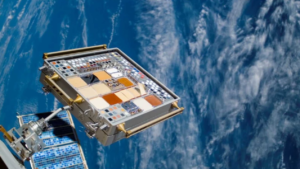
As the International Space Station (ISS) streaks through the night sky at five miles per second, it carries an array of Dayton ingenuity: CRG’s shape memory polymer (SMP) composite samples. Mounted on the exterior of the ISS, these locally engineered materials are braving the harsh environment of space in an experiment marking a significant advancement in material research for future space missions.
This milestone is part of the Materials International Space Station Experiment-19 (MISSE-19), a collaborative project involving NASA and various research entities to test the performance and durability of materials in the harsh space environment. Understanding how they behave under extreme conditions, including exposure to the vacuum of space, temperature fluctuations and radiation, is crucial.
CRG has provided 11 SMP samples, each measuring 3 x 3 inches, of two different composite formulations. These samples were selected based on their potential applications in lunar and Martian environments.
SMP composites combine polymers with other reinforcing components and exhibit the ability to return to a predetermined shape when exposed to an external stimulus, such as heat, light or electrical current. These composites are useful in applications requiring adaptability and resilience, such as biomedical devices, aerospace structures and smart textiles.
The SMP composites being tested will be a foundational component of a new CRG self-aligning, thermally activated reversible joint suitable for various extraterrestrial construction activities. Its low insertion force, high ultimate load capacity, and dust-tolerant features allow for ease of autonomous assembly by robotics and for construction activities on lunar, Martian and asteroid surfaces.
On March 21, 2024, the SpaceX Dragon capsule carrying MISSE-19 successfully launched from the Cape Canaveral Space Force Station. After two days of travel, the capsule docked with the International Space Station (ISS) where NASA astronauts unpacked the MISSE-19 platform. On April 10, the sample carrier was mounted to the exterior of the ISS by a robotic arm, open to the space environment, where the materials will remain for approximately six months, at which time they will be returned to Earth on a future mission.
The primary goal of this experiment is to compare the performance of pre-flight and post-flight samples to assess the impact of space exposure. This research will help determine the viability of these materials for future space applications, including reusable attachment devices for space debris remediation and reversible robotic attachment components for in-space servicing, assembly and manufacturing objectives.
If successful, CRG plans to build dust-tolerant reversible joints from the space-exposed samples and compare the results to unexposed samples. Additionally, CRG has secured a contract with the Center for the Advancement of Science in Space Inc. (CASIS) to send a cyclic test apparatus to the ISS on MISSE-21. This experiment, scheduled for early 2025, will further evaluate the SMP composites by performing attachment and detachment operations for six months.
